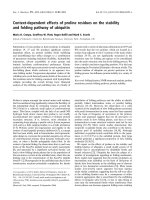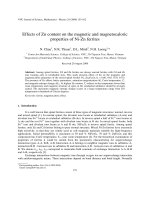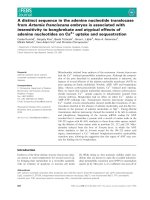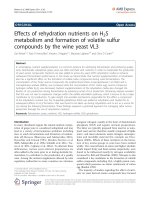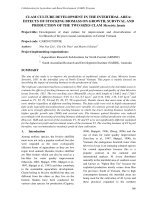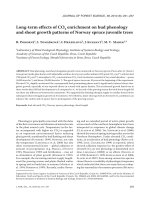Effects of chitosan coating on enzymatic browning and decay
Bạn đang xem bản rút gọn của tài liệu. Xem và tải ngay bản đầy đủ của tài liệu tại đây (165.81 KB, 8 trang )
Postharvest Biology and Technology 12 (1997) 195–202
Effects of chitosan coating on enzymatic browning and decay
during postharvest storage of litchi (Litchi chinensis Sonn.) fruit
Donglin Zhang, Peter C. Quantick *
Food Research Centre, Uni6ersity of Lincolnshire and Humberside,
61
Bargate, Grimsby, North East Lincolnshire DN
34 5
AA, UK
Accepted 3 June 1997
Abstract
Litchi (Litchi chinensis Sonn. cv. Huaizhi) fruit were treated with aqueous solutions of 1.0 or 2.0% chitosan coating
1 h after dipping in 0.1% thiabendazole (TBZ), and then stored at 4°C and 90% relative humidity (RH). Changes in
browning, anthocyanins, flavonoids, total phenolic contents, polyphenol oxidase (PPO) and peroxidase (POD)
activities, and weight loss were measured. The effects of chitosan coating on decay control were also evaluated. The
application of chitosan coating delayed changes in contents of anthocyanin, flavonoid, total phenolics, delayed the
increase in PPO activity, reduced weight loss, and partially inhibited the increase in POD activity. All these changes
corresponded to changes in browning. The application of chitosan coating partially inhibited decay of fruit during
storage. However, increasing the concentration of chitosan coating did not significantly increase the beneficial effects
of chitosan on browning and decay of the fruit. © 1997 Elsevier Science B.V.
Keywords
:
Browning; Chitosan coating; Litchi (Litchi chinensis Sonn. cv. Huaizhi); Peroxidase (POD); Polyphenol
oxidase (PPO); Storage decay
1. Introduction
Litchi (Litchi chinensis Sonn.) is a tropical fruit
of high commercial value in the international fruit
market. However, within 2 or 3 days after harvest
its pericarp becomes desiccated and turns brown;
it decays and its flavour is lost. Storing the fruit
for any longer than 3 or 4 days without treatment
is difficult. Pericarp browning reduces its commer-
cial value and has long been considered the main
postharvest problem (Akamine, 1960). The
browning of litchi fruit pericarp after harvest is
the result of polyphenol oxidase activity (Guang-
dong Postharvest Research Group, 1975; Tan and
Zhou, 1987; Lin et al., 1988a,b), desiccation
(Scott et al., 1982), changes in anthocyanins (Un-
derhill and Critchley, 1994), attack by pathogens
(Chen, 1984), and other unknown factors. At* Corresponding author.
0925-5214/97/$17.00 © 1997 Elsevier Science B.V. All rights reserved.
PII
S0925-5214(97)00057-4
D. Zhang, P.C. Quantick
/
Posthar6est Biology and Technology
12 (1997) 195 – 202
196
present, rapid cooling after harvest and storage at
low temperatures with high humidity, treating
with fungicides and other preservatives, modifying
the atmosphere surrounding the fruit, appropriate
packaging, and treating with SO
2
and acids are
the most prevalent methods for maintaining the
appearance and quality of litchi fruit (Chen et al.,
1986; Chen and Zhang, 1988; Nip, 1988; Zauber-
man et al., 1991). However, a complete solution
to storage problems is not available, and the use
of fungicides on fruits needs strict control due to
potential health risks (Wilson and Wisniewiski,
1989).
Tissue browning of fruits is due to cellular
breakdown leading to mixing of browning-related
enzymes and substrates, which results in enzy-
matic oxidation in the presence of oxygen (Ju and
Zhu, 1988). Therefore, delaying or reducing enzy-
matic oxidation should be an important way to
extend storage life and preserve the quality of the
fruit.
Application of semi-permeable coatings has
been shown to improve the storability of perish-
able crops (Lowings and Cutts, 1982). For exam-
ple, application of Pro-Long coating to bananas
delayed ripening through modifying the internal
atmospheres (Banks, 1984), and ripening was de-
layed in pears and apples coated with Nutri-Save
®
(Davis et al., 1988). However, little research on
semi-permeable coatings for litchi fruit has been
done. York (1994) demonstrated that pericarp
browning of litchi fruit was delayed significantly
by two polysaccharide coatings. Zhang et al.
(1997) found that an edible coating based on
sucrose esters of fatty acids significantly delayed
pericarp browning of litchi fruit.
Chitosan, a high molecular weight cationic
polysaccharide, is soluble in dilute organic acids,
and could theoretically be used as a preservative
coating material for fruits. It can inhibit the
growth of several fungi (Allan and Hadwiger,
1979; El Ghaouth et al., 1989, 1991), induce chiti-
nase, a defense enzyme (Mauch et al., 1984), and
elicit the production of phytoalexin in pea pods
(Kendra and Hadwiger, 1984). Also, due to its
ability to form a semi-permeable film (Bai et al.,
1988), chitosan coating might be expected to
modify the internal atmosphere as well as de-
crease transpiration losses in fruits. A research
study by El Ghaouth et al. (1991) indicates that
chitosan coating has the potential to prolong the
storage life and control decay of strawberries even
at higher storage temperatures, and has the ability
to modify internal atmospheres in strawberries.
Feeding trials with domestic animals have recently
demonstrated that chitosan is non-toxic and bio-
logically safe (Hirano et al., 1990).
The objective of our research was to assess the
potential of chitosan coating in maintaining ap-
pearance and controlling decay of litchi fruit dur-
ing postharvest storage.
2. Methods and materials
2.1.
Plant material
Litchi (Litchi chinensis Sonn. cv. Huaizhi) fruit
were harvested in local farms, Guangdong, China
and transported to the research laboratory within
2 h. Fruits of uniform size with 80% red colour,
free of physical damage, injury caused by insects,
and fungal infection were used, and were dis-
tributed randomly into groups of 15 fruit. Each
group represented one replicate, and for each
treatment three replicates were used. Three dupli-
cate experiments were set up. Fruit were dipped in
0.1% TBZ (thiabendazole, Deco Chemicals), dried
for 1 h, and then treated with aqueous solutions
of 1.0 or 2.0% chitosan. To prepare 100 ml of 1.0
or 2.0% chitosan solutions, 1.0 or 2.0 g of chi-
tosan (Crab-shell chitosan, Sigma Chemicals) was
dispersed in 100 ml of distilled water to which 2 g
of
L
-glutamic acid was added, and the mixture
was heated to dissolve the chitosan. Tween 80 (0.1
ml) was added to the solution to improve wet-
tability. Fruit were allowed to dry for 1 h after
dipping. Fruits dipped in 0.1% TBZ alone were
regarded as the control. They were stored at 4°C,
90% RH. Here we used TBZ-treated fruit as the
control and chitosan treatments in combination
with TBZ as treatments in order to extend storage
time for the assessments of browning, enzyme
activities, and total phenolics.
D. Zhang, P.C. Quantick
/
Posthar6est Biology and Technology
12 (1997) 195 – 202
197
2.2.
Browning assessment
Browning of fruit was assessed by measuring
the extent of the browned area on each fruit
pericarp on the following scale: 0 =no browning;
1= slight browning or a few browning spots;
2= less than 1/4 browning; 3=1/4–1/2 brown-
ing; 4=more than 1/2 browning. The browning
grade was calculated using the following formula:
Browning grade=S (browning scale×proportion
of corresponding fruit within each class).
2.3.
Assays of contents of anthocyanin, total
phenolics, and fla6onoids
Contents of anthocyanins, total phenolics, and
flavonoids were measured according to Pirie and
Mullins (1976). Litchi fruit peel (2 g) were ex-
tracted with 1% HCl–methanol (10 ml), the ho-
mogenate was filtered and washed, and the filtrate
was diluted with 1% HCl–methanol to 50 ml.
Absorption of the diluent was measured at 600
and 530 nm for anthocyanins, 325 nm for
flavonoids, and 280 nm for total phenolics. An-
thocyanin contents were expressed as the change
of 0.1 unit of difference between A
530 nm
and
A
600 nm
. Flavonoid contents were expressed as the
absorbance at 325 nm per g fruit peel. Total
phenolics were calculated from a standard curve
made with gallic acid.
2.4.
Enzyme assays
Fruit peels (2 g) were homogenized in 5 ml of
0.05 M phosphate buffer (pH 6.8) at 4°C. The
homogenate was centrifuged at 19 000× g for 20
min and polyphenol oxidase (PPO) activity in the
supernatant was determined according to the
method of Tan and Li (1984), by measuring the
oxidation of 4-methylcatechol. PPO activity was
calculated as the increase in 0.001 unit of ab-
sorbance per min at 398 nm per mg protein. To
measure peroxidase (POD) activity, fruit peels (2
g) were homogenized in 5 ml of 0.1 M phosphate
buffer (pH 7.1) at 4°C. The homogenate was
centrifuged at 1500× g for 20 min and peroxidase
(POD) in the supernatant was measured accord-
ing to the method of Kochba et al. (1977), and
calculated as the increase in absorbance at 470 nm
per mg protein per min.
2.5.
Control of decay
Fruits were treated with 0.1% TBZ alone or
1.0% chitosan alone or 2.0% chitosan alone, and
then dried for 1 h. To assess the effectiveness of
chitosan on the control of decay and compare it
with the TBZ treatment, we used fruits dipped in
distilled water as the control. They were stored at
4°C with 90% RH. Four replicates of 120 fruits
were used for each treatment. Fruits were exam-
ined for mould regularly and considered infected
when a visible lesion was observed. Results were
expressed as percentage of fruits infected.
2.6.
Determination of weight loss
Four replicates of 60 fruits were used for each
treatment. Fruits were weighed regularly for
weight loss.
2.7.
Protein assays
The protein content of enzyme extracts was
measured according to the method of Bradford
(1976).
2.8.
Data handling
Data were from three duplicate experiments
and were analysed using Duncan’s multiple range
test for least significant difference at the 5% level
and the results were subjected to analysis of vari-
ance with 5% LSD values calculated to separate
significantly different means of the control and
treatments.
3. Results
3.1.
Effects of chitosan coating on browning
Changes in the browning grades of both TBZ-
treated control and chitosan-treated fruits (Table
1) showed that the browning grades of both TBZ-
treated control and chitosan-treated fruits signifi-
D. Zhang, P.C. Quantick
/
Posthar6est Biology and Technology
12 (1997) 195 – 202
198
cantly increased with increased storage time (PB
0.05), indicating that the fruit pericarp turned
brown gradually. The browning grades of chi-
tosan treatments changed significantly more
slowly than that of TBZ-treated control (PB
0.05), while there was no significant difference
between the chitosan treatments according to
Duncan’s multiple range test.
3.2.
Changes of contents of anthocyanin,
fla6onoid, and total phenolics
Changes in the anthocyanin and flavonoid con-
tents of the fruit peel during storage at 4°C are
shown in Figs. 1 and 2. Anthocyanin and
flavonoid contents of both the TBZ-treated con-
trol and chitosan treatments decreased slowly dur-
ing the first 20 days of storage and then decreased
more steeply. Anthocyanin and flavonoid contents
of chitosan treatments decreased more slowly
than in the TBZ-treated control. At days 20, 25
and 30 of storage, there were significant differ-
ences in anthocyanin and flavonoid contents be-
tween chitosan treatments and the TBZ-treated
control (PB0.05). However, there was no signifi-
cant difference in anthocyanin and flavonoid con-
tents between chitosan treatments.
Changes in total phenolics content of the peel
of fruits coated with 1.0 and 2.0% chitosan and in
Fig. 1. Changes in anthocyanin contents of the peel of litchi
fruits coated with 1.0 and 2.0% chitosan and the TBZ-treated
control during storage at 4°C. Each data point represents the
mean of three duplicate experiments where there were three
replicates for each treatment.
the TBZ-treated control during storage at 4°C are
shown in Fig. 3. Total phenolics content de-
creased continuously. The total phenolics contents
of chitosan treatments decreased more slowly
than in the TBZ-treated control fruit. At days 20,
25 and 30 of storage, there were significant differ-
ences in total phenolic contents between chitosan
treatments and the TBZ-treated control (PB
0.05). However, there was no significant difference
between chitosan treatments.
3.3.
Effects of chitosan coating on PPO and
POD acti6ities
Changes in PPO and POD activities of the fruit
peel coated with 1.0 and 2.0% chitosan and of
peel from the TBZ-treated control during storage
at 4°C are shown in Figs. 4 and 5, respectively.
PPO and POD activities of chitosan treatments
changed little during the first 14 days of storage,
while those in the TBZ-treated control changed
significantly. Then, PPO activity of the TBZ-
treated control increased and reached a peak at
day 26, and then decreased. PPO activity of both
chitosan treatments increased slowly and reached
Table 1
Effects of chitosan coating on browning of pericarp of litchi
fruit during storage at 4°C*
Days of Browning grade
storage
2.0% Chitosan1.0% ChitosanControl
0 0ac 0ac 0ac
0.8890.12a d 0.59 9 0.10b d 0.5290.11b d10
1.6490.18a e20 1.1190.17b e 1.0990.15b e
25 2.3790.20a f 1.8290.16b f 1.7890.17b f
2.3690.23b g2.9990.26a g30 2.3090.20b g
3.6790.30a h33 2.8990.25b h 2.8090.26b h
Means within a row followed by the same letter (a and b) and
a column followed by the same letter (c–h) are not signifi-
cantly different at the 0.05 level (n = 9). Each data point
represents the mean of three duplicate experiments where there
were three replicates for each treatment9 S.E. (n=9).
D. Zhang, P.C. Quantick
/
Posthar6est Biology and Technology
12 (1997) 195 – 202
199
a peak at day 31, and then decreased. At day 26
of storage, there was significant difference in PPO
activity between chitosan treatments and the
TBZ-treated control (PB0.05) but no significant
difference between chitosan treatments.
POD activity of both the TBZ-treated control
and chitosan treatments increased continuously
after day 14 of storage. POD activity of chitosan
treatments increased more slowly than the TBZ-
treated control. At days 24, 26, 30 and 33 of
storage, there were significant differences in POD
activity between chitosan treatments and the
TBZ-treated control (PB 0.05). However, there
was no significant difference between chitosan
treatments.
3.4.
Effect of chitosan coating on weight loss of
fruit
During 4°C storage, weight loss of both the
TBZ-treated control and chitosan treatments in-
creased continuously. Weight losses in chitosan
treatments were slower than in the TBZ-treated
control, and there was no significant difference
between chitosan treatments (Table 2).
Fig. 3. Changes in contents of total phenolics of the peel of
litchi fruits coated with 1.0 and 2.0% chitosan and the TBZ-
treated control during storage at 4°C. Each data point repre-
sents the mean of three duplicate experiments where there were
three replicates for each treatment.
3.5.
Effects of chitosan coating on control of
decay
Decay in litchi fruit coated with chitosan alone
and dipped in TBZ alone was significantly re-
duced (Table 3). However, the ability of chitosan
Fig. 2. Changes in flavonoid contents of the peel of litchi fruits
coated with 1.0 and 2.0% chitosan and the TBZ-treated con-
trol during storage at 4°C. Each data point represents the
mean of three duplicate experiments where there were three
replicates for each treatment.
Fig. 4. Changes in polyphenol oxidase activities of the peel of
litchi fruits coated with 1.0 and 2.0% chitosan and the TBZ-
treated control during storage at 4°C. Each data point repre-
sents the mean of three duplicate experiments where there were
three replicates for each treatment.
D. Zhang, P.C. Quantick
/
Posthar6est Biology and Technology
12 (1997) 195 – 202
200
Fig. 5. Changes in peroxidase activities of the peel of litchi
fruits coated with 1.0 and 2.0% chitosan and the TBZ-treated
control during storage at 4°C. Each data point represents the
mean of three duplicate experiments where there were three
replicates for each treatment.
resulting in tissue browning in fruits and vegeta-
bles. It may be involved in breakdown of an-
thocyanin, resulting in colour changes of fruits
and vegetables (Dong, 1990). Lin et al. (1988b)
suggested that peroxidase may be involved in
oxidation of phenolics, glutathione and ascorbic
acid, also resulting in colour changes of fruit and
vegetables.
Coating fruit with semi-permeable films has
generally been shown to retard ripening by modi-
fying the endogenous CO
2
,O
2
and ethylene levels
of fruits (Lowings and Cutts, 1982; Banks, 1984;
El Ghaouth et al., 1991). In our studies, the
application of chitosan coating delayed changes of
contents of anthocyanin, flavonoid, total pheno-
lics, and the increase in PPO activity, and par-
tially inhibited the increase in POD activity which
is associated with tissue browning. This implies
that a chitosan coating may form a protective
barrier on the surface of the fruit and reduce the
supply of oxygen for enzymatic oxidation of phe-
nolics.
Scott et al. (1982) pointed out that desiccation
is one of main factors causing browning of the
fruit. Underhill et al. (1992) indicated that with
the development of litchi fruit, cuticle thickness
decreases significantly and micro-cracking of the
pericarp appears; thus, harvested litchi fruit desic-
cate quickly. During storage, as desiccation oc-
curred, the pH of the pericarp homogenate
increased and the permeability of cell membranes
changed so as to influence the micro-structure of
pericarp cells (Underhill and Critchley, 1994).
Desiccation also prompts the breakdown of vac-
uoles and leakage of anthocyanin and destroys
the compartmentation of browning-related en-
zymes and their substrates (Chen and Hong, 1992;
Underhill and Critchley, 1994). Desiccation can
be reduced by the use of plastic films (Chen and
Zhang, 1988; Nip, 1988; Chen and Hong, 1992).
In our study, the application of chitosan may
form a layer of film on the outer pericarp surface,
reducing weight loss and desiccation of the fruit
(Table 2), and also resulting in less browning.
In some research, chitosan has been shown to
be able to inhibit the growth of some fungi (Allan
and Hadwiger, 1979; El Ghaouth et al., 1989,
1991). In our study, to assess the effectiveness of
to control decay in litchi fruit is limited when
compared to TBZ.
4. Discussion
Oxidation of phenolic compounds is the main
cause of browning in fruits (Macheix et al., 1990).
PPO is a terminal oxidase occurring widely in
plants, which catalyzes oxidation of phenolics,
Table 2
Changes in percentage of weight loss of litchi fruits coated
with 1.0 and 2.0% chitosan and the control during storage at
4°C (%)*
Days of Control 2.0%1.0%
ChitosanChitosanstorage
0a d00ad0a d
7 1.090.1c e1.090.1b e1.390.1a e
2.490.1a f14 2.190.1b f 2.090.1b f
3.790.2a g 3.090.2b g21 3.190.2b g
26 4.190.2b h5.090.2a h 4.190.2b h
30 5.190.2b i6.190.2a i 5.290.2b i
6.190.2b j6.190.2b j33 7.090.2a j
Means within a row followed by the same letter (a–c) and a
column followed by the same letter (d – j) are not significantly
different at 0.05 level (n=9). Each data point represents the
mean of three duplicate experiments where there were three
replicates for each treatment9 S.E. (n=9).
D. Zhang, P.C. Quantick
/
Posthar6est Biology and Technology
12 (1997) 195 – 202
201
Table 3
Changes in percentage of decay of litchi fruits coated with 1.0 and 2.0% chitosan, treated with 0.1% TBZ, and the water-dipped
control during storage at 4°C (%)*
1.0% Chitosan 2.0% ChitosanDays of storage 0.1% TBZControl
0a 0a0 0a0a
0a 0a0a15.591.1b7
9.791.0b 8.591.0b14 0a33.891.7c
28.391.5c 26.891.4c21 65.592.5d 0a
50.992.0d53.392.1d 3.590.6b95.293.2e26
72.192.6e 69.992.5e 7.890.7c30
20.491.3d87.593.1f33 89.193.1f
* Means within a column followed by the same letter are not significantly different at 0.05 level (n=9). Each data point represents
the mean of three duplicate experiments where there were three replicates for each treatment9 S.E. (n=9).
chitosan on the control of decay and compare it
with TBZ treatment, we used water-dipped fruit
as the control. Results indicate that to some ex-
tent the application of chitosan coating delayed
the increase in decay of stored litchi fruit, indicat-
ing that chitosan coating reduced pathogen
growth in some way (Table 3). Since attack by
pathogens is also a major factor causing browning
of the fruit (Chen, 1984), inhibiting decay par-
tially could be beneficial in delaying browning.
The antifungal effects suggested here are in line
with those which El Ghaouth et al. (1991) ob-
served in strawberry. However, the increase in
concentration of chitosan coating did not control
browning or decay of the fruit significantly more,
and also the effectiveness of chitosan on decay
control is far from reaching that of TBZ and so is
limited. Further studies will be needed to fully
evaluate the action model of chitosan coating and
the possibility of it replacing the use of fungicides.
Taste panels of the stored fruits were done
regularly while the other assessments were taken
and no off-flavours in chitosan-treated fruits were
detected because the low temperature of storage
reduced physiological metabolism.
We suggest that the application of chitosan
coating could be beneficial in the control of
browning and to some extent could be beneficial
in decay control of litchi fruit. In using chitosan
for decay control, we consider it might be suitable
for treatment of fruit stored for shorter periods
(e.g. 2 weeks), for short-distance transport and
distribution. We recommend the application of
chitosan coating to control browning and decay
in litchi fruit in combination with other methods
such as low temperature and suitable packaging.
References
Akamine, E.K., 1960. Preventing the darkening of fresh litchi
prepared for export. Tech. Progr. Rep. Hawaii Agric. Exp.
Stat. 127, 1–17.
Allan, C.R., Hadwiger, L.A., 1979. The fungicidal effect of
chitosan on fungi of varying cell wall composition. Exp.
Mycol. 3, 285–287.
Bai, R.K., Huang, M.Y., Jiang, Y.Y., 1988. Selective perme-
abilities of chitosan–acetic acid complex membrane and
chitosan–polymer complex membrane for oxygen and car-
bon dioxide. Polym. Bull. 20, 83–86.
Banks, N.H., 1984. Some effects of TAL Pro-Long coating on
ripening bananas. J. Exp. Bot. 35, 127–137.
Bradford, M.M., 1976. A rapid and sensitive method for the
quantitation of microgram quantities of protein using the
principle of protein-dye binding. Anal. Biochem. 72, 248–
254.
Chen, F., Li, Y.B., Chen, M.D., 1986. The production of
ethylene of litchi fruit during storage and its control. Acta
Hortic. Sin. 13, 152–156.
Chen, M.D., Zhang, D.L., 1988. Studies on postharvest physi-
ology and technology of litchi fruit during storage. China
Fruit Res. 4, 1–4.
Chen, W.J., Hong, Q.Z., 1992. Studies on senescence and
browning of Litchi fruit pericarp during storage. Acta
Hortic. Sin. 19 (3), 227–232.
Chen, W.S., 1984. A brief profile on studies of postharvest
storage of litchi fruit. Litchi Sci. Bull. 34, 47–51.
Davis, D.H., Elson, C.M., Hayes, E.R., 1988. N,O-car-
boxymethyl chitosan, a new water soluble chitin derivative.
Proc. 4th Int. Conf. Chitin and Chitosan, Trondhein,
Norway, 22–24 August, pp. 467–475.
D. Zhang, P.C. Quantick
/
Posthar6est Biology and Technology
12 (1997) 195 – 202
202
Dong, J.H., 1990. The browning of several tropical fruit and
their polyphenol oxidases. Tropic. Crops Res. 2, 92–99.
El Ghaouth, A., Ponnampalam, R., Arul, J., 1989. Anti-fungal
properties of chitosan and chitosan fragments. Presented at
the 34th Annual Meeting of Canadian Society of Horticul-
tural Sciences, Montreal, Quebec, Canada, July 9–13.
El Ghaouth, A., Arul, J., Ponnampalam, R., Boulet, M., 1991.
Chitosan coating effect on storability and quality of fresh
strawberries. J. Food Sci. 56, 1618–1620.
Guangdong Postharvest Research Group, 1975. Studies on
prevention of peel browning of frozen litchi fruit. Acta
Bot. Sin. 17, 303–308.
Hirano, S., Itakura, C., Seino, H., Akiyama, Y., Nonaka, I.,
Kanbara, N., Kawakami, T., 1990. Chitosan as an ingredi-
ent for domestic animal feeds. J. Agric. Food Chem. 38,
1214–1217.
Ju, Z.G., Zhu, G.L., 1988. Research on tissue browning of
fruits during storage. Plant Physiol. Commun. 4, 46–48.
Kendra, D.F., Hadwiger, L.A., 1984. Characterization of the
smallest chitosan oligomer that is maximally antifungal to
Fusarium solani and elicits pisatin formation in Pisum
sati6um. Exp. Mycol. 8, 276–278.
Kochba, J., Lavee, S., Spiege-Roy, P., 1977. Differences in
peroxidase activity and isoenzymes in embryogenic and
non-embryogenic ‘Shamouti’ orange-ovular callus lines.
Plant Cell Physiol. 18, 463–465.
Lin, Z.F., Li, S.S., Zhang, D.L., Lin, G.Z., Li, Y.B., Liu, S.X.,
Chen, M.D., 1988a. The changes of pigments, phenolics
contents and activities of polyphenol oxidase and pheno-
lalanine ammonia-lyase in pericarp of postharvest litchi
fruit. Acta Bot. Sin. 30, 40–45.
Lin, Z.F., Li, S.S., Zhang, D.L., Liu, S.X., Li, Y.B., Lin, G.Z.,
Chen, M.D., 1988b. The changes of oxidation and peroxi-
dation in postharvest litchi fruit. Acta Bot. Sin. 30, 382–
387.
Lowings, P.H., Cutts, D.F., 1982. The preservation of fresh
fruits and vegetables. In: Proc. Institute of the Food Sci-
ence and Technology Annual Symp., Nottingham, UK,
July 1981, vol. 15, pp. 52–54.
Macheix, J.J., Fleuriet, A., Billot, J., 1990. Fruit Phenolics.
CRC Press, Boca Raton, FL, pp. 1–24.
Mauch, F., Hadwiger, L.A., Boller, T., 1984. Ethylene: symp-
tom, not signal for the induction of chitinase and i-1,3-
glucanase in pea pods by pathogens and elicitors. Plant
Physiol. 76, 607–610.
Nip, W.K., 1988. Handling and preservation of lychee with
emphasis on colour retention. Tropic. Sci. 28, 5–11.
Pirie, A., Mullins, M.G., 1976. Changes in anthocyanin and
phenolic content of grapevine leaf and fruit tissue treated
with sucrose, nitrate and abscisic acid. Plant Physiol. 58,
468–472.
Scott, K.J., Brown, B.I., Chaplin, G.R., Wilcox, M.E., Bain,
J.M., 1982. The control of rotting and browning of lychee
fruit by hot benomyl and plastic film. Sci. Hortic. 16,
253–262.
Tan, X.J., Li, Y.B., 1984. Partial purification and properties of
polyphenol oxidase in litchi fruit peel. Acta Phytophys.
Sin. 10, 339–346.
Tan, X.J., Zhou, Y.C., 1987. Studies on the enzymatic brown-
ing of Litchi chinensis pericarp by polyphenol oxidase.
Acta Phytophys. Sin. 13, 197–203.
Underhill, S.J.R., Bagshaw, J., Prasad, A., Zauberman, G.,
Ronen, R., Fuchs, Y., 1992. The control of Litchi posthar-
vest skin browning using sulphur dioxide and low pH.
Acta Hortic. 321, 732–741.
Underhill, S.J.R., Critchley, C., 1994. Anthocyanin decolouri-
sation and its role in lychee pericarp browning. Aust. J.
Exp. Agric. 34, 115–122.
Wilson, C.L., Wisniewiski, M.E., 1989. Biological control of
postharvest diseases of fruit and vegetables: an emerging
technology. Annu. Rev. Phytopath. 27, 425–441.
York, G.M., 1994. An evaluation of two experimental polysac-
caride Nature Seal Registered coatings in delaying the
postharvest browning of the lychee pericarp. Proc. Florida
State Hortic. Soc. 107, 350–351.
Zauberman, G., Ronen, R., Akerman, M., Weksler, A., Rot,
I., Fuchs, Y., 1991. Postharvest retention of the red colour
of litchi fruit pericarp. Sci. Hortic. 47, 89–97.
Zhang, D.L., Liu, S.X., Li, Y.B., Chen, F., Guo, C.Y.,
Quantick, P.C., Warren, P., 1997. Effect of an edible
coating—a sucrose ester of fatty acids on colour changes
of Litchi fruit during storage. J. Troic. Subtropic. Bot. 5,
54–60 (in Chinese with English Abstract).
.
